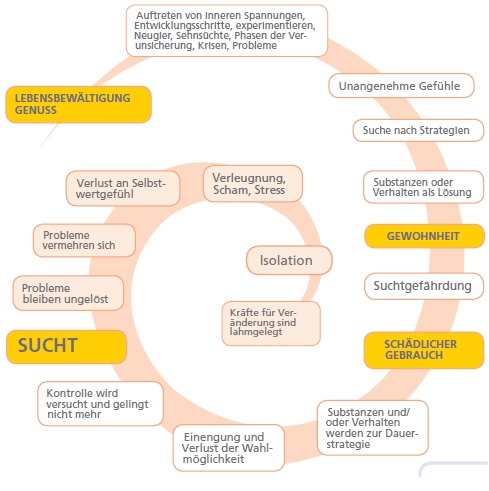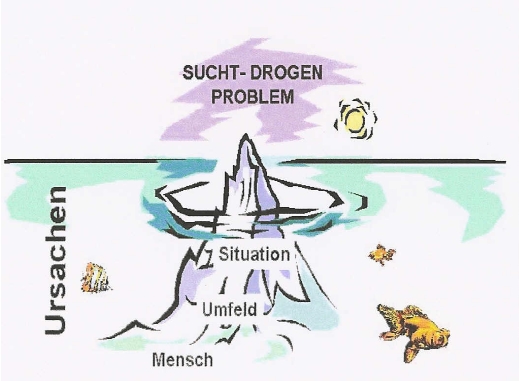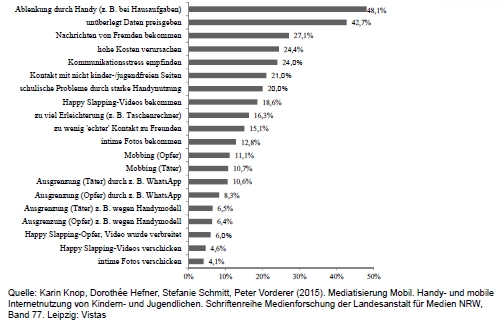Content
• Addiction in general
• Media & Addiction
• Causes or Sources
• Prevention and Therapy
Competencies
• Establishing social contacts
• Ability to cooperate and work in a team
• Training in reaction speed
• Training to focus attention in games
• Experience of self-efficacy and autonomy
The spiral of addiction….

Addictive behavior as a problem-solving attempt
“Media addiction” as a collective term
Media — everyday life, fascination & addiction

Classification
- ICD-10 and DSM‑V do not contain any fixed criteria for behavioral addictions in general
- Possibility to classify them as “habits and disorders of impulse control” (F. 63.8)
- “Gaming disorder” has been classifiable as a disease since mid-2018. Classified in the ICD-11 in the field of mental, behavioral and neurodevelopmental disorders.
- In the DSM‑5, the “Internet Gaming Disorder” was recorded as an independent disorder — “recommended for further investigations”
“Gaming Disorder” (ICD-11)
Usage behavior characterized by
- decreased control over behavior execution
- excessive importance of playing, which displaces other fields of interest and everyday activities
- continued use despite associated negative consequences Symptoms persist for a period of 12 months. Diagnosis can also be made earlier in justified cases.
“Internet Gaming Disorder” (preliminary criteria DSM‑5)
- Use of computer games as dominant occupation
- Withdrawal symptoms when consumption is prevented
- Tolerance development
- Loss of control
- Loss of interest
- Continuation of consumption despite negative consequences
- Concealment of the extent of use
- Emotion regulation through the use of computer games
- Endangering important interpersonal relationships
For a diagnosis to be made, at least 5 out of 9 criteria must have been met in the last 12 months.
Online content / behavior
• Online computer games
• Online computer games
• Aimless surfing
• Online pornography
• Social media
• Online shopping
• Streaming / Videos
• Gathering information
• ….
Prevalence and Psychosocial Correlates of Internet Gaming Disorder
Study based on a representative sample of 12 to 25 year olds Lutz Wartberg, Levente Kriston, Rainer Thomasius
- In the primary analysis, there was a prevalence estimate of 5.7% for Internet gaming disorder in the age group of 12 to 25 year olds in Germany and in the sensitivity analysis (with multiple imputations missing values) the prevalence estimate rose to 7.0%.
- Male respondents (8.4%) had a significantly higher prevalence estimate for Internet gaming disorder than female respondents (2.9%).
- Statistically significant associations were observed between Internet gaming disorder and male gender, lower age, higher levels of depression, higher levels of anxiety and more frequent neglect of social contacts due to the use of computer games.
ICEBERG MODEL

Media and attractiveness
• Affiliation
• Recognition
• Obligation
• Self-presentation
Virtual identity
Nickname, avatars, characters
Virtual lifestyle
- selectable and changeable
Experiment with identity
- Normal development in adolescents
- Peer group connection and autonomy
It’s about …
- Experience flow
- entertainment
- Impersonation and playing with identity
- Social contacts
- Belonging and Recognition
- Mood management
- Satisfaction of needs
Particularly at risk are people with
- Affectives and Anxiety Disorders
- Depression
- Attention deficit hyperactivity disorder (ADHD)
- excessive neuroticism (i.e. high anxiety, excessive susceptibility to stress, negative self-image)
- significantly reduced extraversion (strong tendencies to withdraw and high social vulnerability)
“Media addiction” and prevention — in particular
Media as …
- Immobilizer
- Emotion regulator
- Communication substitute
“We don’t need to raise our children, they imitate everything we do anyway.“
Karl Valentin
Media Use <> Media Consumption
Experienced risks in children and adolescents

According to this, “46 percent of 8 to 14 year olds have a cell phone or smartphone with them all day, 38 percent have the device within reach for at least half of the day. 64 percent of children and adolescents have a mobile device with Internet access, while the figure for 13 and 14 year olds is already 86 percent. More than a fifth of all children and adolescents between the ages of 8 and 14 have a “very strong bond” to their smartphone or cell phone. About 8 percent attested the researchers a kind of addiction risk. The most important application is the WhatsApp instant messenger. 72 percent of 8 to 14 year olds stated that they use this app several times a day. 32 percent check their Facebook page once a day. ”
“With increasing age, the cell phone becomes more relevant and a part of the people themselves”.
“The fear of missing out on something important encourages young people to use online applications in an often uncontrolled and risky manner.”
“Dr. Karin Knop from the Institute for Media and Communication Studies at the University of Mannheim reported that 15 percent of the parents surveyed refrained from any cell phone education. Mostly, media education in families is limited to prohibitions or maximum limits for smartphone use. Active upbringing rarely takes place. …
Knop explained that it is not only explicit educational measures that determine how adolescents deal with mobile Internet use, but also the parents’ media use and the quality of the relationship between them and the children. “Insecure ties can lead to riskier use,” warned the media scientist. …
Only those who oppose the always-online trend with a trusting relationship can positively influence the personality development of young people in the sense that self-control and the ability to reflect on smartphones contribute to sensible use. ”
Source: Always online and yet alone? LfM symposium: How children and young people use the smartphone
01.10.2015, Düsseldorf
“Media Addiction” and Prevention — In General
Development of the child from 0 to 6 years
| binding | “It is good to be.” | (0–15 months) |
| Exploration | “It is good to explore.” | (15 — 30 months) |
| identity | “It’s good to be you.” | (30 — 48 months) |
| competence | “It’s good to be strong.” | (48 — 72 months) |
Children and …
- Self-confidence
- Responsibility and obligations
- Limits and rules
- Disappointments and failures
- Conflicts
- Feelings and needs
- Creativity and imagination
Therapeutic approaches
- Clarification of motivation
- Reconstruction of media and addiction behavior. What is the significance of the behavior for the person concerned?
- Distancing yourself from the addictive medium. Development of independent ways of social control.
- Risk prevention and relapse management
- Involvement of relatives.
- Groups (relatives, affected persons)
Ways out
In order to be able to get well, the person concerned must be able to access his injuries.
Rediscovery and awareness of your own needs and abilities.
The addictive behavior is perhaps comparable to a crutch for a stressed leg! The crutch weakens the constitution of the leg over time. Walking and standing are no longer possible without them.
Therapy is about understanding the function of the crutch as well as uncovering the injury, pain or weakness in the leg — and healing it.
